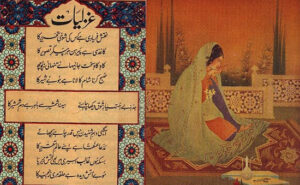
Urdu, a language that beautifully amalgamates Persian, Arabic, and Indian elements, has a rich and complex history. Its origins can be found in the 12th century, it emerged as a vernacular form of the Persian language in the Indian subcontinent. The interaction between the native people and the Persian-speaking rulers eventually led to this language fusion. Nastaliq, an aesthetically appealing fusion of Arabic and Persian calligraphy, is the unique script that Urdu has created over time. The history of India is a tapestry with diverse cultures, languages, and traditions, each contributing its unique threads to the nation’s rich heritage. Urdu stands out as a remarkable linguistic and cultural force among the many languages that have significantly impacted India’s history. In this article, we will explore the profound influence of Urdu on India’s history, tracing its origins, evolution, and impact on various aspects of Indian society over the centuries. Urdu, or ‘ordu,’ is derived from the Turkish word for army or “camp language.”Ghulam Hamadani Mushafi is credited with coining the name Urdu in 1780.
Urdu’s influence on India’s history is truly remarkable and far-reaching. From the majestic Mughal era to the present day, Urdu has played a pivotal role in shaping the cultural, literary, and societal fabric of India. Let’s delve deeper into its impact across various domains.
In the realm of literature, Urdu poetry has left an indelible mark. The eloquent verses of legendary poets like Mirza Ghalib, Allama Iqbal, and Faiz Ahmed Faiz continue to resonate with the hearts and minds of people. Their words beautifully express emotions, love, and social consciousness, making Urdu poetry an integral part of India’s literary heritage.
During the freedom struggle, Urdu became a powerful tool for unity and resistance. It served as a medium of expression, allowing poets and writers to voice their aspirations for a free India. The progressive Urdu literature movement, led by visionaries like Sajjad Zaheer and Ismat Chughtai, challenged societal norms and advocated for social justice.
Urdu’s influence extends beyond literature. It has enriched the world of music, theater, and cinema. The soul-stirring melodies of ghazals and qawwalis in Urdu captivate audiences, while Urdu dialogues and scripts in Bollywood films add depth and authenticity to storytelling. Moreover, Urdu has contributed to cultural harmony and unity. It has served as a link between many communities, cutting through linguistic divides and establishing a sense of shared heritage. Festivals like Jashn-e-Rekhta emphasize the cultural relevance and aesthetic value of the Urdu language, thereby enhancing its appeal.

The growth and patronage of Urdu were greatly aided by the Mughal Empire, which existed from the 16th to the 19th century. The Mughal rulers were not only enthusiastic supporters of the arts and culture but also enthusiastic Persian speakers and authors, which had a big impact on Urdu. Because of this, Urdu acquired a sophisticated literary heritage, with poets like Mir Taqi Mir, Mirza Ghalib, and Allama Iqbal permanently influencing the language’s poetry tradition. Even today, despite time and linguistic limitations, their ghazals and nazms remain.
The influence of Urdu extends outside of literature. It was essential to the Indian independence movement against British colonial control. Leaders like Maulana Abul Kalam Azad, a well-known freedom fighter and an accomplished speaker in both Urdu and English, used the language as a potent instrument to inspire the populace and express their hopes for independence. Newspapers and periodicals in Urdu, like “Al-Hilal,” were useful tools for promoting social reform, freedom, and unification. The ability of Urdu to act as a link between various linguistic and religious communities in India is one of its most outstanding qualities. Although developed in a predominately Muslim cultural environment, it has crossed religious barriers and evolved into a universal language. Hindus, Sikhs, Christians, and Muslims all spoke and loved Urdu in pre-independence India, establishing a sense of community and a common cultural legacy.
Urdu continues to be an integral part of Indian culture and linguistics. In several regions of the nation, it is extensively spoken. Some of the states where it is predominantly spoken include Uttar Pradesh, Madhya Pradesh, Andhra Pradesh, Telangana, Karnataka, and Maharashtra. Urdu is infused with ‘tehzeeb’ and ‘tameez’ in Uttar Pradesh. The language discovers its original essence and fizzes with joy.Various universities teach Urdu, and several literary magazines and publications in Urdu are widespread and accessible nationwide. Renowned Urdu literary figures include Ismat Chughtai, Rajinder Singh Bedi, Ali Sardar Jafri, Firaq Gorakhpuri, and Qurratulain Hyder. In addition, it is impossible to envision the language without Mirza Ghalib or Mir Taqi Mir. Urdu has been heavily used in Bollywood, shayari, poetry, music, and other cultural mediums. It is the source of qawwali, gazal, and mushairas. Thus, it may be said that Urdu has gracefully and elegantly weaved itself into India’s cultural past.
In conclusion, Urdu has had a significant impact on India’s history and cultural landscape. Its beginnings date back to the 12th century, and it has evolved through centuries of linguistic fusion and cultural exchange. Urdu serves as a monument to the unity in diversity that characterizes India, from its place in literature home to legendary poets like Mirza Ghalib and Allama Iqbal to its significance in the liberation movement and its ongoing influence on music, theater, and film. Its enduring relevance is further demonstrated by its capacity to cross-linguistic and theological barriers, serving as a bridge for intercultural cooperation. Urdu, a language that elegantly combines Persian, Arabic, and Indian characteristics, continues to be a crucial component of India’s linguistic history, incorporating its elegance into the country’s tapestry of cultural expression.

